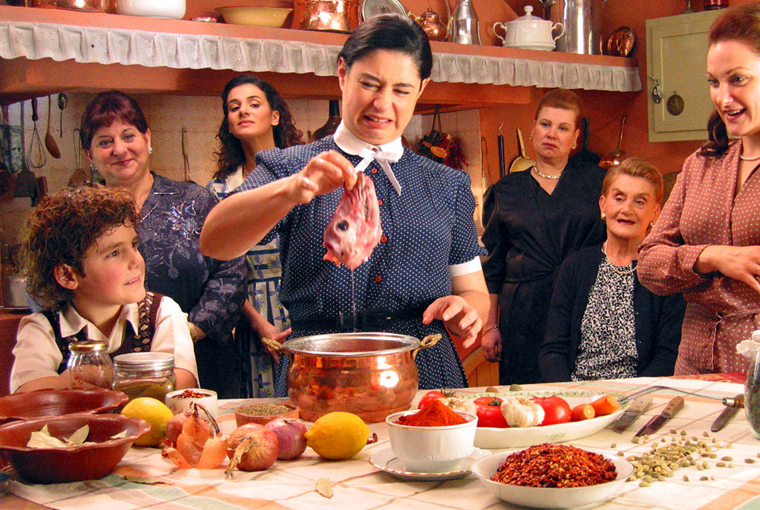Gustative Sensorium
Food as Transnational Object in Balkan Cinema
Vol. 58 (October 2015) by Ana Grgić
Food is central to many cultures, though in the Balkans certain dishes are truly transnational – they carry an imprint (the embodied memory) of a common cultural and socio-historical past left behind by diverse civilizations and populations inhabiting the peninsula. While certain dishes may have mutated and acquired local characteristics, they often share the same genealogy, like the tasty cheese filled pastry found across the region under different names: börek (Turkish), byrek (Albanian), tyropita (Greek), burek (Bosnian/Croat/Serb), banitsa (Bulgarian) etc. In many local films, food functions as a recollection-object which generates sensations in the body of the viewer, thus becoming an occasion for remembering in a sensual manner which is particularly significant in the Balkans where food plays a central role in the social life of individuals. Due to the loss of real places of memory, and the conviviality of communities of different ethnic, religious and linguistic backgrounds, this recollective function is transnational rather than being merely local. Though I provide a short excursion through the symbolism of food in world and Balkan cinema, I mainly focus on a recent documentary to discuss this aspect, Tonislav Hristov’s Soul Food Stories (Istorija za hranata i dushata, 2013), which explores social, political, gender and historical issues through activities associated with food and cooking in a small Bulgarian village, Satovcha. The Satovcha community, composed of different religious and ethnic groups, namely Orthodox Christians, Muslim Turks/Slavs (Pomacs) and Evangelist Gypsies, provides a microcosm in which the Balkan complex and multi-layered identity can be explored. To underline how food becomes a recurring trope for discussing transnational identities in the Balkans, I also examine the popular feature film A Touch of Spice (Politiki Kouzina, 2003) by Tassos Boulmetis, which uses food to explore identity and to address the sensitive issue of ethnic Greek deportation from Istanbul and Turkey in the 1920s, 1950s and early 1960s.
The use of food in cinema to engage the spectator’s body and explore human relationships in a visual and sensual way is not new. Images of food, eating and of sharing food around the table have been present since the early days of cinema. From the very beginning, food has been a symbol of family, social life and interaction. For instance, one of the first films ever to be made, Baby’s Lunch (Le Déjeuner de bébé, 1895) by the the brothers Lumière, depicts the familiar scene of a mother and father feeding their baby. Similarly, the oldest preserved silent Greek fiction film, Villar’s Adventures (I peripeties tou Villar, Joseph Hepp, 1924), a Athens-set slapstick chase comedy starring burlesque comedian Nikos Sfakianakis, features a “surreal” wedding lunch scene at the Acropolis. Title-lending Villar gets a job at a dry cleaner’s, but falls in love and chases his prospective sweetheart all over Athens: from the neoclassical buildings of Stadiou Str. through the seaside suburb of Phaliron, his desperate chase finally takes him to the Herodus Atticus ancient theater. The food scene, where the wedding party consume spaghetti, literally takes place in the middle of a deserted street with a Greek temple in the background, providing a source of comic relief.
There are a number of famous food movies in world cinematography, such as Tampopo (Juzo Itami, 1986), Like Water for Chocolate (Alfonso Arau, 1992), Babette’s Feast (Gabriel Axel, 1987) and Eat Drink Man Woman (Ang Lee, 1994), which feature key dining scenes and use food as a metaphor for human relationships. Food and eating function as a sensual medium through which larger issues are explored: family life, love, conflict etc. In Eat Drink Man Woman, exquisite tasty dishes remain uneaten as the family which is at the center of the story sulks around the table. Like Water for Chocolate, on the other hand, explores the sensual pleasures of food. Here cooking and eating are loving gestures that provoke passion and sexual tension. In Tampopo, the famous ramen soup scene becomes a moment of sharing generational memory: the instructions on how to eat ramen are accompanied by a classical symphony, each gesture seeming like a dance. Lastly, in Babette’s Feast, protagonist Babette uses lottery prize money to prepare a sensual feast of exotic and sumptuous food in appreciation of her Danish host family. The meal thus becomes an occasion to rekindle old love and a redemption of the spirit in this formerly austere environment.
The motive is also popular among many Eastern European filmmakers. In recent Romanian cinema, the dinner table has become a place of conflict. Film critic Mihail Chirilov identifies several examples of scenes set around the table in Romanian films that provide faithful representations of a realistic environment in which the everydayness of the setting allows for a close reading of the characters.1 Furthermore, Raluca Iacob maintains that one of the recurring tropes in almost all Romanian films over the last two decades, has been that of characters sitting around the table eating.2 Iacob discusses the two key aspects of dinner scenes in Romanian films, “the ability to give a (false) sense of community and the capacity to provide the space for family conflicts to unfold”, through the birthday party scene in 4 Months, 3 Weeks and 2 Days (4 luni, 3 săptămâni și 2 zile, 2007), which Otilia attends after having suffered her traumatic experience. An ideological use of food is traceable in Želimir Žilnik’s Early Works (Rani Radovi, 1969) about a traveling band of young activists, where political and social criticism is offered through the depiction of the food that revolutionaries (presumably) eat.3 Jugoslava and her band make their meals with whatever materials are at hand: they roast sausages over boilers on a rooftop, cook over a campfire, and play catch with piles of cabbage before eating them. In addition, Jugoslava’s family meals are “depicted as exercises in minimalism” as the family consumes milk and apples, while Jugoslava herself eats bread and butter after a sexual encounter. Working classes are forced to survive through a basic and low means of subsistence, which reflects in the food they eat – the most basic need any human can have.4 Yet another Yugoslav documentary from the period, Love (Ljubav, 1973) by Vlatko Gilić, centers on a husband and wife having a meal together at a construction site in the midst of the mountains. Half of the film’s length is dedicated to the husband and wife having lunch together, therefore highlighting this as a privileged moment and exceptional act: they use wooden planks to improvise a table and stools, the wife takes the various dishes and food out from the basket, the husband eats, and they look at each other and talk. The lunch scene provides the conditions for depicting love between husband and wife, for caring gazes and caressing movements.
Food as performative, cultural memory
Film scholar Laura U. Marks explores food and plants that can function as recollection-objects in contemporary intercultural films and videos. “As a recollection-object breaks down, through the engagement with memory, memory generates sensations in the body […]. Thus an image, insofar as it engages with memory at all, engages the memory of the senses. […] The memory of the senses may call forth histories of transnational objects, histories that have been lost en route.”5 She uses Winnicott’s theory of the transitional object to explore how fetish is produced on the body without organs – the subject’s identity is consequently distributed between the self and the object; while the self is in transition, the object remains the same despite taking on layers of meaning. “The transnational object is a transitional object not only for the person in transition from one cultural reality to another, but also for the one whose cultural reality is entered and changed. The object becomes a means of both their projections about the other culture.”6 Thus C. Nadia Seremetakis devotes a chapter of The Senses Still (1994) to a peach called rodhakino that was once cultivated in the region of Greece where she grew up, but which has practically disappeared from the market with the rise of mass agricultural marketing in Greece. Nowadays, this peach exists only in the memory of those who used to eat it. Commenting on Serematakis’ peach, Marks remarks how “these memories remain embodied in the senses even when their stimulus has disappeared”7. Food can thus become a potent vehicle for memory in absence of other records, and since “every culture privileges certain sense modalities as vehicles for knowledge, food is more important within gustatory epistemologies”8. Thus, “food provides not only a source of performative, shared cultural memory but also a marker of many kinds of disjunction: of generation, language, class, and place”9. The emphasis on the pleasures of sharing a meal in the Balkans is intimately inherent in the social and cultural practice of the everyday.
This year, I had the opportunity to view Soul Food Stories (Istorija za hranata i dushata, 2013) at the food-themed Divan Film Festival, which takes place in Cetate, Romania at the end of August each year.10 The first scene presents seven men sitting around a table in a local bar, with plates of food (tomatoes, olives, and cucumbers) and bottles on the table, and a voice-over that offers the viewer a short exposition: “Here we solve all the problems in the bar between friends. Every evening, at the same table, you can see Gypsys, Muslims and Christians…” This scene sets the tone for the film that offers a glimpse of the daily reality of the Satovcha community, which is composed of seemingly conflicting religious and ethnic individuals who nonetheless live side by side in this small Bulgarian village. For instance, the traditional filo pastry filled with cheese and eggs, banitsa, sets the pretext for the Muslim Bulgarian family to discuss religious fasting with Finnish tourists who are visiting the village (the film is a Bulgarian-Finnish co-production). The wives talk about the last fast, when the men actually drank some rakija, thus compromising the religious sanctity of the cleansing, and the entire family joke and laugh about this fact and about their religious duties. One of the men discusses gender roles, such as women’s belonging home and to the family, which role attribution is underlined by one of the wives making minced beef patties as they converse.
The sequence then shifts to a hall filled with the women from the village who eat and drink coffee around the table. In this pensioners’ club (meant primarily for men), the women from the village meet once a week on Wednesdays, the market day, to talk, eat and drink, and we discover that they are planning to request another meeting day per week from the club’s chairman. All the characters provided with individual portraits within the documentary are seen preparing and eating food (and all consume tomatoes). Even chairman Popartsov spreads butter on a loaf of bread, cuts salami and grates cheese for a grilled sandwich while discussing the issue of the women meetings at the club. The women’s request is also discussed and argued over at the bar by the seven men, who each expose their own solution to the problem: the creation of a women-only club; sharing the existing club with women; denying women another day’s access to the club etc. Then, images of flour sieving and of dough being kneaded for the banitsa pastry are again interposed in the kitchen, where the local women discuss traditional gender roles in Satovcha and North America with the Finnish guest and her daughter, who lives in the USA. Through this sort of food journey, the spectators shall take part in a wedding and funeral.
Without a visible didactic or ideological stance, the humorous documentary allows the narrative to unfold through daily activities revolving around food. We are provided with a series of vignettes of the men from the village while they prepare and eat typical dishes in the privacy of their homes, images which are juxtaposed with their voice-over narratives… Thus, the presence of contradicting faiths and opinions is exposed and shown to co-exist in the microcosm of this small village. There is a member of the Communist party true to the ideals of socialism, the former Communist party leader of Satovcha who speaks about the fate of religion under Communism, the oldest man and widower in the village recalling WWII-time hardships, and finally a stout Bulgarian who’s chairman of the right-wing party Ataka which is associated with the Bulgarian Orthodox Church. By the end of the documentary, the identity and convictions of all the men whom we encounter around the table at the film’s beginning are revealed, and so, a re-assessment of the previously seen images is necessary. However, what emerges is the possibility of conviviality despite differing views and beliefs; we find men discussing the issue of homosexuality, and while they reach no consensus, their meal concludes when one of the men exclaims that even “Alexander the Great was gay”!
Political cuisine
In yet another Balkan film, Tassos Boulmetis’ Greek-Turkish A Touch of Spice (Politiki Kouzina, 2003), identity and memory politics are explored through the incorporation of cooking, eating and feeling. It was chosen for the first edition of the Balkan Film and Food Festival, which takes place each year in September in the Albanian town of Pogradec by the lake Ohrid, yet another Balkan space of crossroads. Like any Greco-Turkish meal, this fiction film, which incorporates subtle comic tones, is divided into three parts; “mezedes” (appetizers), “main dishes” and “desserts”. It tells the story of Fanis, a forty-year-old astronomer, and his grandfather Vassilis, a grocery store owner in Istanbul. Through flashbacks, the story also addresses the deportation of ethnic Greeks from the multi-cultural city of Istanbul, which Fanis’ family is subject to, and explores national identity through typical Constantinople-like cuisine. After being forced to move to Greece, Fanis and his family reconnect with their beloved city and evoke memories through cooking, tasting and eating traditional dishes from the past. The original Greek title – “Politiki Kouzina” – is a play on words that connotes both “political cuisine” and “Cuisine of the Polis”, the latter being a reference to “Constantinopolis”, the original Greek name for Istanbul.
Fanis’ grandfather, Vassilis, attributes a cosmic dimension to food. He shares his wisdom with Fanis and his customers by way of brief excursions into philosophy: “Cinnamon brings people together, makes them look at each other in the eyes; cumin, on the other hand, closes people off.” In a flashback scene, Fanis receives a lesson on astronomy and the philosophy of good life through spices, as his grandfather tells him that “gastronomy” contains the words “astronomy”. And “life, like food,” he adds, “requires salt, too”. In another scene, the sharing of meze (appetizers), which introduces us to different meals, depicts a convivial moment for the entire family. Particularly significant is the way postcards are deployed as recollection objects throughout the film. Towards the beginning of the film, Vassilis tells his grand-son Fanis and Saime, a Turkish girl who’s Fanis’ childhood love, about different cities and their identities by rubbing postcards against different spices. Later into the film, when Fanis receives postcards, they function as recollection objects, both through visual apperception but also through the olfactory sense. The memory of the senses recalls the history of transnational objects and the transnational journey and identity of ethnic Greeks from Constantinople. Through allusions to food, the complex political relationship between Greece and Turkey is explored, for instance in the scene when Saime’s husband returns to Istanbul and finds Fanis present. The sensitive and tense issue is simply evoked through Saime’s husband recognizing cinnamon in the cufte (meatballs) which helps him determine whether he’s arrived too late to save his marriage, or not.
The sense of disbelonging of Istanbulite Greeks in Greece (where they were perceived as Turks), is constantly broached, firstly by stressing the specific and unique character of the “Cuisine of the Polis”, but also through their way of experiencing food. At the very start, when Fanis prepares dinner for his grandfather’s arrival in Greece, his grandfather’s friends from Constantinople are depicted as being different and in search of a geographical identity. Indeed, in a comical sketch, their sense of orientation in their new home country, Greece, is constantly wrong. The popular explanation for this fault, says the narrator, is the wrong diet; while most people use smell and taste for food, the Constantinople Greeks use also sight and ears. Their difference from Greeks in the film is emphasized through (and attributed to) their particular cuisine, which is transnational, Greco-Turkish, and as such unable to assume a single, clear national identity. Lydia Papadimitriou maintains that the absence of nationalist rhetoric in the story, its sensitive manner of dealing with the deportation issue and the fact that it is a Greek-Turkish coproduction, all signal a positive move in the relationship between the two countries.11
In Soul Food Stories and Politiki Kouzina, food functions as a recollection-object, which generates sensations in the body of the viewer, and consequently becomes an occasion for remembering through the senses. While the metaphor of food has been used in world cinematography, in the Balkans, food and rituals surrounding cooking and eating, play a central role in the social life of individuals, the family and the community (Soul Food Stories). Specific dishes and local cuisines as a whole, embody and carry a particular transnational history of the region, which at times evokes nostalgic and painful memories, but also retains sensual and cosmic qualities (Politiki Kouzina). Because of the centrality of food in Balkan culture, its presence and symbolism in cinema – not only in relation to human relationships, but in equal measure to that of identity politics – becomes a revelatory object capable of evoking and provoking cultural memories. In both films discussed above, food turns into a potent vehicle for memory, and knowledge. Perhaps the answer to conflicting beliefs and short-sighted nationalism does indeed lie at the table.




Leave a Comment